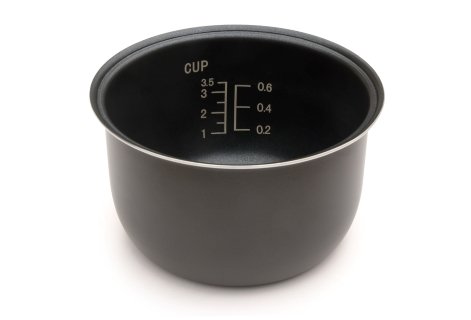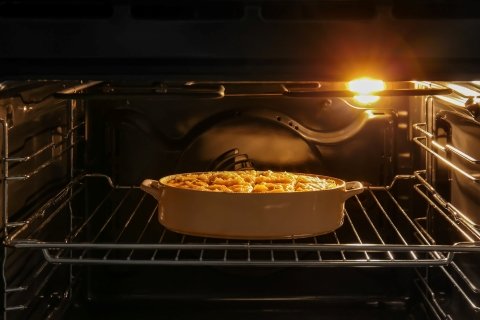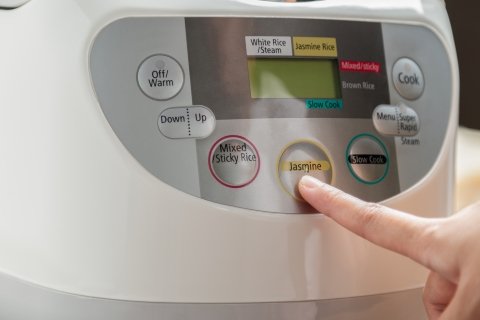A rice cooker makes it so easy to make rice for the night without having to supervise the process. But there may come a time when the power goes on the blink and you ask yourself, can you put a rice cooker pot on the stove to finish cooking? Well, before that happens, the answer is that it’s safer not to. While there is a type of rice cooker pot that can take the heat of electric and gas stoves, the risks are just a few too many to actually consider doing it.
From understanding the risks of putting a cooker pot on the stove to finding alternative ways to use it, you might want to read along till the end of this article.
Table of Contents
What Are Rice Cooker Pots Made of?
While rice cooker pans (inner pots) are made of a variety of materials, the most common type available is an aluminum rice cooker pan with a non-stick Teflon coating. These are designed to distribute heat evenly by the cooker’s thick metal heating plate and conform to one standard temperature.

There are other cooker pots that come with ceramic or stainless steel pans instead, though these don’t come with a non-stick coating. For the most budget-friendly and convenient-to-use option, aluminum pots are more often sought after than the others. An important thing to remember is that these pans are made with such materials to best suit their own heating systems, not stoves where the heat source is higher and concentrated in spots.
Is it Safe to Place the Inner Rice Cooker Pot on a Stovetop?
Though it is established that there are risks to putting the inner rice cooker pot on a stovetop, risks which we shall discuss shortly, you may find yourself in a position where you need to finish cooking your rice on the stove. But is there a rice cooker pan that is safe on a stove? Let’s look into some common rice cooker pots and see.
Aluminum Inner Rice Cooker Insert
Many of the best modern rice cookers on the market today are made of aluminum and coated with Teflon. Although it’s great to use within its own outer heating pot, it’s not advised to use an aluminum rice pan on an electric stove or gas stove. Because of how unstable gas stove flames can be when heating any cooking vessel, parts of the aluminum pan will likely be overheated once the water evaporates, leading to damage to the non-stick Teflon coating. The pan may also get warped over time if used directly on a gas stove. These pans are usually very thin to best suit the rice cooker pot’s heating temperatures.
The concentrated heat on the bottom from a stove will be too much for the pan to handle, and like most other flimsy pots and pans, will warp over time (faster than vessels made for stovetop cooking), making it unusable in its original rice cooker pot.
However, if the temperature is kept low on an induction stove, then the pan itself should be fine even with multiple uses. But, the main problem you will face in this instance is sticking or even burning the food, which will eventually ruin the pan.
Ceramic Inner Rice Cooker Insert
Ceramic inner rice cooker pots are dangerous to use on any type of stove for multiple reasons. Being ceramic, they will crack and break due to sudden temperature changes induced by stoves. Once the pot breaks, you have 2 things to clean up – first, the food mess it would have created around the hot stove, and second, broken pottery will be mixed in with it.
Another possible risk is that the food could catch fire after the breakage or oil from the food can seep through a crack and onto the flame or hot burner. All these hazards can only be avoided if you keep your ceramic rice cooker pan in its rightful place, inside the cooker pot.
Stainless Steel Inner Rice Cooker Insert
Stainless steel cooker pots are quite high in demand due to their durability and non-toxic material. Being such an indestructible cooker pot, this can be used on stoves with almost no risk involved. There are 2 things, however, you should keep in mind.
Due to the absence of a non-stick coating, food is very likely to stick more than in other rice cooker pots. Over time, using it on a stove could also cause discoloration or burn stains around the outer bottom if left on high heat for too long. The latter is more likely on gas stoves than electric stoves. Inside the pot, stains may also develop if the rice sticks and remains stuck for too long. These stains are nearly impossible to remove by washing. But all things considered, using it on a stove once in a while shouldn’t give you any problems.
There are 2 more important things to consider before you decide to move your inner pot from the cooker to the stove. We’re very used to using vessels with handles around the kitchen. One issue with all types of inner rice cooker pots is that they lack proper handles. If you’re using it on the stove, then you would need a handle to take your pot out, which will be quite hard to do with the large “lip” at the top of most rice cooker pots. However, if you have potholders, then they could help in this case.
Lastly, the manufacturers warn against using electric cooker pots on any stovetops due to the many risks and hazards involved. Though this may be seen as a way of warning that it may not be usable with its original cooker pot after use on a stove, there are also many safety risks that are highly likely to occur, as we discussed above.
Can You Put a Rice Cooker Pot In the Oven?
Only a metal/stainless steel rice cooker pot is safe to put inside an oven. An aluminum pot will definitely deform and bend under oven temperatures, while a ceramic pot may be at risk of cracking. Maximum temperatures a pot can take are sometimes mentioned in the manual of the cooker pot, which may help you decide if it is safe or not to put into an oven. But if not, then there’s the risk of breakage, melting, and possible fire hazards involved.

Among all pots, however, metal pots are the least risky to use. Some will still have a non-stick coating, which is why it is advised to preheat the oven and keep the temperature below 400 degrees F. If this is followed and not done too often, the pot can still be used in its own cooker pot.
Finishing the cooking in the oven is also a way to reduce excess liquid that you may have accidentally added, as this cooking method is known for drying out foods if the dish is left uncovered.
Can You Put a Rice Cooker Pot In the Microwave?
Using anything besides containers labeled as “microwave friendly” will always be a big risk to the vessel you put in there and the microwave itself. The most common microwavable containers are made of glass, durable plastic, and ceramic.
Metal pots are inadvisable and dangerous to use in microwaves. No matter the thickness, the metal will not be penetrated by microwaves. Instead, the waves might cause sparking which can ruin the microwave and has the potential to cause a fire.
Ceramic pots, on the other hand, are the safest type of inner rice cooker pots to put into a microwave. These are usually labeled to be microwave safe. Any other type of pot will have either a non-stick coating or a small component of metal which are hazardous to use in microwaves.
What Should I Do When the Electricity Goes on the Blink?

If the electricity goes off on a blink while your rice is cooking in the cooker pot, then there are a couple of things you could try to finish the cook. First, try to transfer your food to another stove-safe pot or vessel in which it can continue to cook. This is an easy but potentially messy way of continuing your cook as most rice cooker pots may not have handles to help you with the transfer.
If you’re low on light and don’t want to struggle to clean anything up if there’s a spillage, then you could instead simply use a heat diffuser on the stove. Instead of directly letting the flames hit the inner cooker pot, place a pan on top of the burner which will act as a “heat diffuser”, making it safe for your rice cooker pot to resume cooking on a stove.
Keep the heat at a medium until you feel the rice is done. If the heat is any higher, it could warp the pot or the rice could get stuck. You may need to add more water accordingly, as some of it could evaporate during this process. Once the rice is done, take it off the pan immediately and put it on the countertop.

